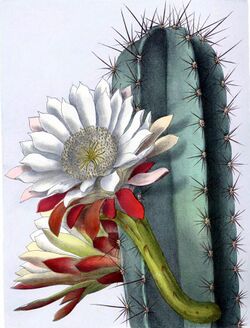Biology:Cereeae
| Cereeae | |
|---|---|

| |
| Cereus repandus | |
| Scientific classification | |
| Kingdom: | Plantae |
| Clade: | Tracheophytes |
| Clade: | Angiosperms |
| Clade: | Eudicots |
| Order: | Caryophyllales |
| Family: | Cactaceae |
| Subfamily: | Cactoideae |
| Tribe: | Cereeae |
| Type genus | |
| Cereus | |
| Subtribes | |
|
See text. | |
| Synonyms | |
|
Trichocereeae Buxb. (1958) | |
Cereeae is a tribe of cacti belonging to the subfamily Cactoideae containing about 50 genera, divided among three subtribes Cereinae, Rebutiinae and Trichocereinae.
Description
Cereeae are tree-like or shrubby, sometimes climbing plants. Their mostly elongated to spherical, ribbed and thorny shoots are not articulated. The flowers, which usually appear on the side of the shoot, open during the day or at night. Their pericarpels usually have a few scales or are completely glabrous. The fleshy, berry-like, bursting or non-bursting fruits often have a blackening adherent flower remnant. The small to large seeds are oval. The hilum and micropyle of the seeds are fused, one appendage is absent.[1]
Taxonomy
In classifications before the use of molecular phylogenetic methods, Cereeae was one of nine tribes into which the subfamily Cactoideae was divided. Molecular studies found that these traditional tribes were not monophyletic. A broader circumscription of Cereeae, including Browningieae and Trichocereeae and comprising most columnar cacti of South American origin, was found to be monophyletic.[2] (As of 2023), with this circumscription, Cereeae is divided into three subtribes: Rebutiinae, Trichocereinae and Cereinae. A 2021 study suggested that Trichocereinae and Cereinae are monophyletic, but that Rebutiinae is not.[3]
Subtribes
Historically, the circumscription of subtribes and genera in the Cereeae has been "highly controversial", and subject to considerable change.[3] Three subtribes are accepted (As of September 2023):[2][3]
- Cereinae Britton & Rose – about 13 genera
- Rebutiinae Donald – about 8 genera
- Trichocereinae Buxb. – about 27 genera
References
- ↑ Anderson, Edward F.; Eggli, Urs (2005) (in de). Das grosse Kakteen-Lexikon. Stuttgart (Hohenheim): Ulmer. p. 58. ISBN 3-8001-4573-1.
- ↑ 2.0 2.1 Nyffeler, R.; Eggli, U. (2010), "A farewell to dated ideas and concepts: molecular phylogenetics and a revised suprageneric classification of the family Cactaceae", Schumannia 6: 109–149, doi:10.5167/uzh-43285
- ↑ 3.0 3.1 3.2 Fantinati, Mariana R.; Soffiatti, Patricia; Calvente, Alice (2021), "A New Phylogenetic Hypothesis for Cereinae (Cactaceae) Points to a Monophyletic Subtribe", Systematic Botany 46 (3): 689–699, doi:10.1600/036364421X16312068417020, https://www.researchgate.net/profile/Alice-Calvente/publication/355551622_A_New_Phylogenetic_Hypothesis_for_Cereinae_Cactaceae_Points_to_a_Monophyletic_Subtribe/links/6411bc35315dfb4cce80c363/A-New-Phylogenetic-Hypothesis-for-Cereinae-Cactaceae-Points-to-a-Monophyletic-Subtribe.pdf, retrieved 2023-09-28
Wikidata ☰ Q1054906 entry
 |

